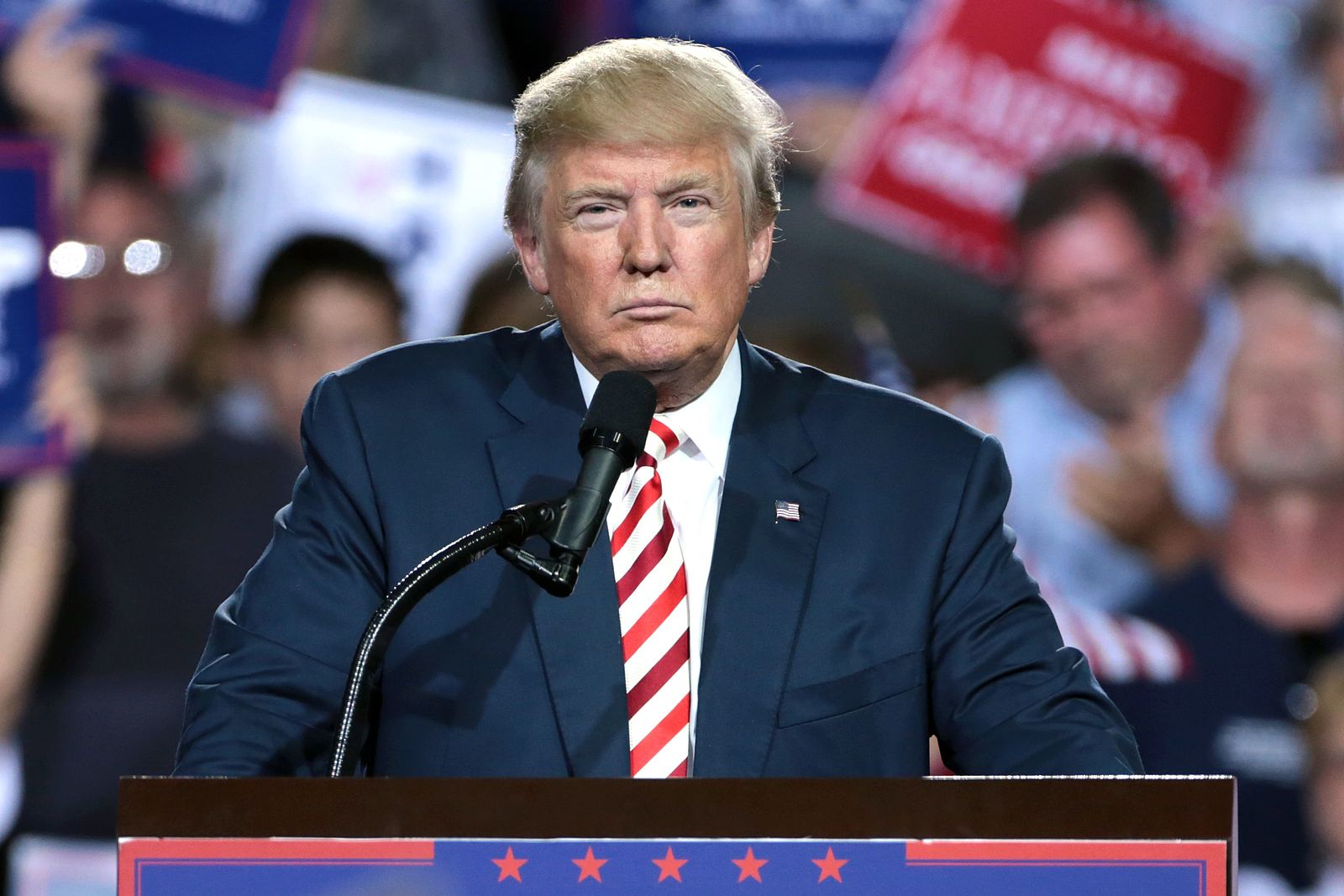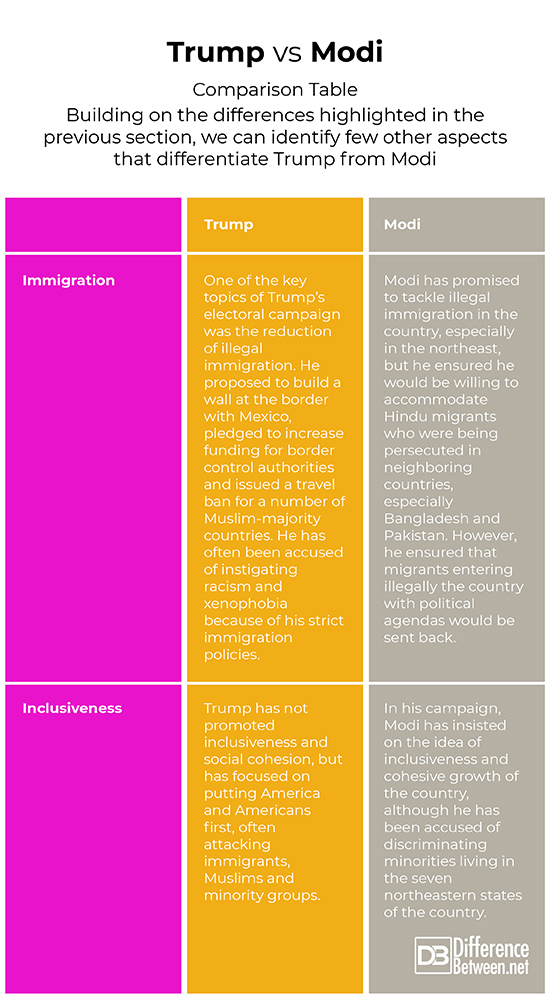Difference Between Trump and Modi
Donald Trump is the President of the United States, while Narendra Damodardas Modi is the 14th Prime Minister of India. The two leaders are often compared because they rule two of the largest democracies – as well as two of the strongest economies – in the world. Both politicians are right-wing-leaning and promote nationalist policies, but they face very different situations in their countries. The US is a developed country and one of the strongest economies worldwide, while India is unevenly developed and – while it is one of the world’s fastest growing economies – it remains well behind the United States in terms of social, political and economic development. India also faces problems linked to over-population, while the United States has seen the national birth rate decrease in the past few years.
Despite a number of similarities in their political views, Trump and Modi have very different backgrounds and based their campaigns and political careers on different elements. Both politicians have insisted on the importance of promoting their own country and favoring the national economy, but Trump has also highlighted the need of stricter foreign policies and immigration laws, while Modi has mainly focused on domestic problems.

Who is Donald Trump?
Donald Trump is the 45th and current president of the United States. He was born in Queens, New York, in 1946 and was a businessman and TV personality before entering into politics. His background is very different from the history and career path of many political leaders, and his victory in the 2016 Presidential elections over Democrat Hillary Clinton came as a surprise to many. During the Presidential campaign, Trump insisted on the importance of “making America great again” by taking jobs back to the United States and imposing stricter immigration policies. During his presidency, Trump implemented a number of policies, including:
- Ordering a travel ban on citizens from several Muslim-majority countries;
- Rescinding the individual insurance mandate provision of the Affordable Care Act;
- Opening the Arctic Refuge for oil drilling;
- Pursuing the “America First” agenda in foreign policies by withdrawing the US from a number of international treaties – including the Paris Agreements, the Trans-Pacific Partnership and the Iran nuclear deal – and by pushing for the revision of other treaties, including NAFTA;
- Recognizing Jerusalem as the capital of Israel and moving the US embassy to Jerusalem;
- Negotiating with North Korea in order to achieve denuclearization;
- Imposing new sanctions on Iran;
- Imposing stricter border-control policies; and
- Triggering a trade war with China.

Who is Modi?
Narendra Modi is the 14th and current Prime Minister of India, after winning the elections in 2014. Born in Vadnagar in 1950, Modi helped his family selling tea as a child and was introduced to the Rashtriya Swayamsevak Sangh (RSS) – a right-wing party – when he was only eight. After rejecting an arranged marriage, Modi travelled around India for two years and started working full-time for the RSS in 1971. He held various positions within the party until 2001, when he was appointed Chief Minister of Gujarat. Modi and his administration have been accused of being complicit in the 2002 Gujarat riots and have been criticized for failing to significantly tackle poverty as well as health and education problems, although he was praised for fostering economic growth. Modi was elected 14th Prime Minister of India in 2014, and some of the policies he implemented since then include:
- Trying to increase foreign investments in India;
- Increasing funding for infrastructures;
- Reducing spending on healthcare;
- Abolishing environmental and labor laws in order to make it more difficult for workers to form unions;
- Introducing the “Make in India” initiative to encourage international firms to invest in the country and to manufacture their products in India;
- Demonetizing ₹500 and ₹1000 banknotes in order to crack down the black market. This decision had a detrimental impact on many citizens and small business and was harshly criticized by the opposition;
- Launching the New Health Policy, which emphasized the role of private health care organizations; and
- Abolishing a number of environmental regulations.
Similarities Between Trump and Modi
Trump and Modi are the leaders of two of the world’s largest democracies, although their two countries are very different from each other. Both lead right-wing parties – the Republicans and the BJP – and both were chosen to represent their parties facing strong opposition. Some of the key similarities between Trump and Modi are listed below:
- Both aim at strengthening their countries by promoting national economies;
- Both disregard environmental policies: Trump pulled out of the Paris Agreements, authorized oil drillings in key areas and promoted the use of coal, while Modi drastically reduced funding for Ministry of Environment, Forests, and Climate Change and abolished a number of environmental regulations, especially those linked to industrial activity;
- Both have emphasized the role of private healthcare organizations and health-insurance providers;
- Both have faced strong opposition both within and outside their parties; and
- Both have attempted to modify the national healthcare system.
What is the Difference Between Trump and Modi?
Despite a number of similarities between the two leaders and their political views, Trump and Modi are very different. Some of the differences between the two stem from the fact that the United States and India are very different countries, despite being two of the largest democracies in the world.
- Background: Trump has a unique background, which makes him a unique political figure. Before entering into politics, he was a businessman and a TV personality. He worked in real estate, faced numerous bankruptcies and hosted the TV show The Apprentice. He often expressed his support for the Republican party but only entered into politics when he decided to run for President during the 2016 elections. Conversely, Modi comes from a poor family, and helped his father selling tea when he was only a child. He entered into politics when he was very young and occupied a number of roles within the RSS before becoming India’s 14th Prime Minister in 2014; and
- Foreign policy: while foreign policy was a key element of Trump’s campaign, Modi has always focused more on domestic policies, trying to reduce poverty and cracking down the black market. Trump’s foreign policy has often been hostile: he withdrew from a number of international agreements, engaged in a war trade with China, imposed new sanctions on Iran, and imposed stricter sanctions on North Korea. Trump also withdrew the US from the United Nations Human Rights Council and questioned the effectiveness of the UN. Conversely, Modi has used a more moderate approach and has travelled extensively across Asia and the entire world to improve relations with a number of countries. He has also tried to attract international funding in order to foster economic growth.
Trump vs Modi: Comparison Table
Building on the differences highlighted in the previous section, we can identify few other aspects that differentiate Trump from Modi.

Summary of Trump vs Modi
Donald Trump and Narendra Modi are often compared for being the leaders of two of the world’s largest democracies. Both politicians are right-wing-leaning and both have shown little interest for environmental laws and climate change. In addition, both have been often criticized both within and outside their parties, and both have taken unpopular decisions. However, despite a number of similarities, Trump and Modi are quite different. Trump has been very aggressive in his foreign policies, withdrawing from international treaties and harshly criticizing other world leaders, while Modi has opted for a more moderate approach in foreign affairs, focusing on improving economic and political ties with several countries, especially in Asia. In addition, Modi has become the 14th Prime Minister of India after years of political activity in the RSS party, while Trump has a past as businessman and TV personality, and had showed little interest in politics before deciding to run for elections in 2016.
- Difference Between Michelle Obama and Melania - January 29, 2019
- Difference Between Trump and Modi - December 4, 2018
- Difference Between Carbon Tax And Cap And Trade - December 4, 2018
Search DifferenceBetween.net :
1 Comment
Leave a Response
References :
[0]Image credit: https://commons.wikimedia.org/wiki/File:Narendra_Modi_(2017-07-07).jpg
[1]Image credit: https://commons.wikimedia.org/wiki/File:Donald_Trump_(29496131773).jpg
[2]Coll, Steve. "The strongman problem: From Modi to Trump." The New Yorker (2017).
[3]Hall, Ian. "Is a ‘Modi doctrine’emerging in Indian foreign policy?." Australian Journal of International Affairs 69.3 (2015): 247-252.
[4]Samet, Jonathan M., Thomas A. Burke, and Bernard D. Goldstein. "The Trump administration and the environment—heed the science." (2017): 1182-1188.

Clearly, Modi is looking forward to remove family business in politics. Introduction of his own family mates will land him on a total different side of what Trump is!